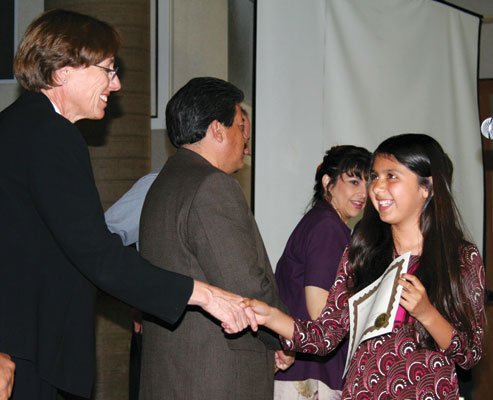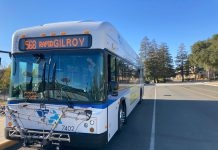Cameras flashed, mothers dabbed tears from the corners of their
eyes and 241 bilingual students paraded across a stage to accept
certificates of their linguistic achievement after years of hard
work.
These students came to the Gilroy Unified School District
possessing a range of English proficiency
– some spoke none, others were nearly fluent. Nonetheless, they
were reclassified as bilingual before a packed house Thursday
night.
Cameras flashed, mothers dabbed tears from the corners of their eyes and 241 bilingual students paraded across a stage to accept certificates of their linguistic achievement after years of hard work.
These students came to the Gilroy Unified School District possessing a range of English proficiency – some spoke none, others were nearly fluent. Nonetheless, they were reclassified as bilingual before a packed house Thursday night.
“What mother wouldn’t be happy?” said Alma Garcia of her daughter’s success. Christina Garcia, 11, now speaks English without a trace of her Spanish accent. Her mother moved to the U.S. when she was 17 and works hard to support her children as a single parent. Her original language still hampers her ability to speak and understand English, she said.
“You need to take the opportunity that you were born over here and they have good schools,” she said. “They are more important than anything else,” she added of her children.
“I always get so excited,” she said when the ceremony was about to start.
Nearly 700 people crammed into the Gilroy High School student center, estimated Angelina Rojas, the district’s administrative assistant for state and federal programs. Although the last three years have remained steady in terms of number of students reclassified, she’s seen a huge increase since she started her job seven years ago, she said. In 2003, only 120 students were reclassified.
If a student’s home language is not English, the student’s language proficiency is tested upon entering the district, Rojas said. The student then goes through a series of bilingual classes – some take years to complete – before taking the California English Language Development Test. Success on the CELDT, along with positive teacher and parent evaluations and success on standardized tests qualifies a student for reclassification.
The CELDT assesses listening and speaking skills of English learners in kindergarten and first grade, and listening, speaking, reading, and writing skills in grades two through 12. The skills and vocabulary tested become progressively more advanced as the children age.
Members of the school board, Superintendent Deborah Flores and each school’s principal attended the reclassification ceremony. Mayor Al Pinheiro gave a brief speech via video and former GUSD student Jairo Rodriguez spoke about his struggle to become bilingual. He pointed out that knowing two languages helps to bridge the gap between cultures.
“A person that’s bilingual is an asset to any school or job,” he concluded. After graduating high school, Rodriguez received a full scholarship from Stanford University, Rojas said. He delivered his speech in both English and Spanish. When he was reclassified 10 years ago, only 20 other students were at his side.
“Learning to speak in two languages is an exceptional ability,” Flores said when she took her turn at the microphone. “I wish I could say I possess this ability.” Although Flores speaks little Spanish, she said she recognizes the importance and hopes her young son will one day be bilingual.
When it was time for the students to accept their awards, Marsella Mercedes Olmas of Ascencion Solorsano Middle School shook the superintendent’s hand and took the microphone to say “I’m proud to be bilingual,” to the loud cheers of the audience.
Compared to the rest of the nation, California has the greatest number of students whose primary language is not English. More than 100 languages are spoken by the state’s English learners, of which about 85 percent speak Spanish, according to the California Department of Education.














